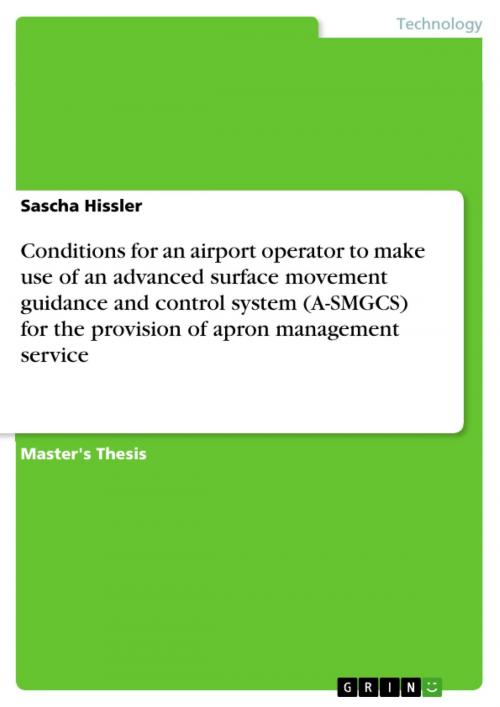Conditions for an airport operator to make use of an advanced surface movement guidance and control system (A-SMGCS) for the provision of apron management service
Nonfiction, Science & Nature, Technology, Aeronautics & Astronautics| Author: | Sascha Hissler | ISBN: | 9783640852444 |
| Publisher: | GRIN Publishing | Publication: | March 7, 2011 |
| Imprint: | GRIN Publishing | Language: | English |
| Author: | Sascha Hissler |
| ISBN: | 9783640852444 |
| Publisher: | GRIN Publishing |
| Publication: | March 7, 2011 |
| Imprint: | GRIN Publishing |
| Language: | English |
Master's Thesis from the year 2010 in the subject Engineering - Aerospace Technology, grade: 1,3, University of Applied Sciences Wildau (WIT Wildau Institute of Technology), course: Aviation Management, language: English, abstract: With the amendment of the European Regulation (EC) No 216/2008 by the new Regulation (EC) No 1108/2009 (into force since 14 December 2009), the area of competency of the European Aviation Safety Agency (EASA) is progressively extended towards a 'total system approach' including ATM, ANS as well as airport safety and interoperability. This new regulation allows airport operators to continue with providing apron management service - but they have to 'declare their capability' for offering this service within the certification process of the aerodrome. An advanced surface movement guidance and control system is one important tool for providing this service at large and complex airports. With the implementation of an advanced surface movement guidance and control system (A-SMGCS), the airport contributes to the precise surface guidance of aircraft to and from a runway while maintaining safe distance to each other as well as to obstacles and vehicles. The system is aimed to assist the ground controllers in managing the traffic situation on the movement area in all weather conditions. Due to advanced surveillance technology, the ground movement controllers are able to continue operations with an A-SMGCS even in low visibility conditions (e.g. due to fog) and maintaining nearly the same capacity as with no visibility restrictions. The focus of this master thesis is not on the operational and technical details of the system, which are profoundly analyzed and elaborated on by R&D projects, e.g. by the German Aerospace Center (DLR), European research projects and the industry. However, the second chapter will provide those details required to fully understand the legal and administrative aspects of an A-SMGCS. If ANSP are using a system like A- SMGCS under safety aspects, they have to undergo a licensing process according to SES-regulations and are licenced by the national supervisory authority. The airport itself is licenced by the appropriate approving authority of the federal state. For Germany's biggest airport, Frankfurt International Airport, it's the ministry of transport of Hesse, the HMWVL. This ministry licences the airport as such as well as the safe provision of apron management service including the use of procedures and technical systems like A-SMGCS. The conditions for this approval are subject of the Master's Thesis.
Master's Thesis from the year 2010 in the subject Engineering - Aerospace Technology, grade: 1,3, University of Applied Sciences Wildau (WIT Wildau Institute of Technology), course: Aviation Management, language: English, abstract: With the amendment of the European Regulation (EC) No 216/2008 by the new Regulation (EC) No 1108/2009 (into force since 14 December 2009), the area of competency of the European Aviation Safety Agency (EASA) is progressively extended towards a 'total system approach' including ATM, ANS as well as airport safety and interoperability. This new regulation allows airport operators to continue with providing apron management service - but they have to 'declare their capability' for offering this service within the certification process of the aerodrome. An advanced surface movement guidance and control system is one important tool for providing this service at large and complex airports. With the implementation of an advanced surface movement guidance and control system (A-SMGCS), the airport contributes to the precise surface guidance of aircraft to and from a runway while maintaining safe distance to each other as well as to obstacles and vehicles. The system is aimed to assist the ground controllers in managing the traffic situation on the movement area in all weather conditions. Due to advanced surveillance technology, the ground movement controllers are able to continue operations with an A-SMGCS even in low visibility conditions (e.g. due to fog) and maintaining nearly the same capacity as with no visibility restrictions. The focus of this master thesis is not on the operational and technical details of the system, which are profoundly analyzed and elaborated on by R&D projects, e.g. by the German Aerospace Center (DLR), European research projects and the industry. However, the second chapter will provide those details required to fully understand the legal and administrative aspects of an A-SMGCS. If ANSP are using a system like A- SMGCS under safety aspects, they have to undergo a licensing process according to SES-regulations and are licenced by the national supervisory authority. The airport itself is licenced by the appropriate approving authority of the federal state. For Germany's biggest airport, Frankfurt International Airport, it's the ministry of transport of Hesse, the HMWVL. This ministry licences the airport as such as well as the safe provision of apron management service including the use of procedures and technical systems like A-SMGCS. The conditions for this approval are subject of the Master's Thesis.















